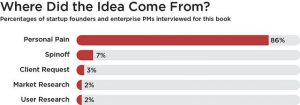(this book review was originally published on The UX Bookclub)
I’ve been a freelance UX’er for over a year now, and somehow I’ve fallen in to the niche of working only with entrepreneurs. All of my clients are startups in one phase or another. And when I’m approached by a new client, they almost always request the same thing:
“I just need you to help me figure out my MVP.”
Every single one of my clients is well-read about Lean, and they are enthusiastic about creating their first MVP. They appreciate how the practice can save them time, effort, and money. What they don’t realize, and what I usually work with them on, is that an MVP is less about building the product, and more about discovering the true nature of the problem.
When I started reading Validating Product Ideas by Tomer Sharon, I instantly understood what he was trying to do: teach entrepreneurs how tolove the problem, not the vision. I’ve been trying to help my clients with this through hands-on, user-research practice. Now I might start assigning reading “homework” from Validating Product Ideas too.
The book starts with an impressive description of how entrepreneurs become founders of a start-up. Sharon bases this description on his own experience working with start-ups, as well as 200+ entrepreneur interviews he conducted as part of creating this book.

One of the most interesting data points is where entrepreneurs get the idea for their start-up. In Sharon’s interviews, he found that ~86% of entrepreneurs get their idea from some sort of personal pain. This means that the majority of entrepreneurs start their project based on anecdotal experience, as compared that to the mere 2% that got their idea directly from user research. Of course, personal experience is as good of a reason as any to develop a product idea, but you can’t stop your investigation there. Entrepreneurs need to jump into user research as early in the process as they can.
From there, Sharon dives into step-by-step instruction on how to answer three big questions you need to answer for every new product:
- What do people need?
- What do people want?
- Can they use the thing?
Sharon also describes this book as a “doing” book, not a “reading” book. This means that the book is not designed to be consumed all at once. Rather he intends for you to read the appropriate sections of the book once you get to that phase of the product development process.
The content of the book is methods light, in that he only describes one or two methods per big question. But what he does provide instruction on he does well. What I really appreciated is that he points you towards methods that are easy to do well, like interviews and observations, and steers you away from methods that are easy to get wrong. For example, he has the following advice about running surveys:
“…a survey is probably the hardest research technique to do right, and I don’t encourage you to do it. Running a proper survey is a science that requires expertise. It’s very easy to ask very wrong questions in a survey and gather biased, misleading ‘data’.” (p. 79)
When I read this section I said a loud, “Amen!” Because I can’t tell you how often I’ve had to break a client’s heart over the “quick survey” they want to run.
Overall, I really recommend this book to anyone who wants to dip their toe into user research and do the work of validating a product idea. I wouldn’t recommend it to be your only guide to learning user-research techniques, especially if this is a field that you want to become a professional in, but if you are looking for the “CliffsNotes” summary then this book is for you.Especially if you call yourself an entrepreneur.
Book Club Discussion
- What’s the one piece of UX advice you’d give to a novice entrepreneur
- What’s your method of choice for problem discovery?
Want to buy it? Get a discount.
The lovely people at Rosenfeld Media have provided us with a discount code to give our followers.
Discount code: TheUXBookClub

